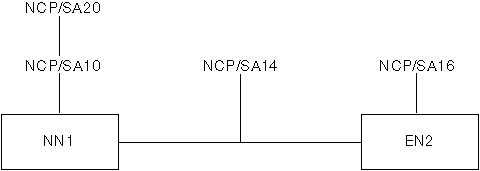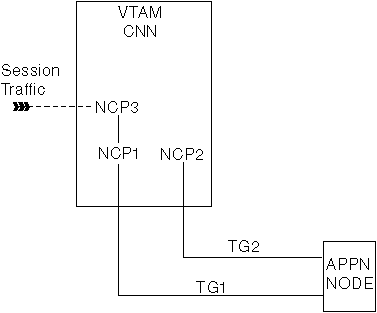 z/OS Communications Server: SNA Network Implementation Guide
z/OS Communications Server: SNA Network Implementation Guide
 z/OS Communications Server: SNA Network Implementation Guide
z/OS Communications Server: SNA Network Implementation Guide
|
Previous topic |
Next topic |
Contents |
Contact z/OS |
Library |
PDF
Subarea number mapping z/OS Communications Server: SNA Network Implementation Guide SC27-3672-01 |
|
|
While APPN topology and routing services is not normally aware of the subarea connectivity within the CNN, the SAMAP table can be used to provide NCP-to-NCP mapping information that can be used to improve the intra-CNN routing in many cases. Figure 1 illustrates a typical session
path scenario.
Figure 1. Typical CNN
session path
 In the above scenario, each of the three NCPs (subarea 10, 14, and 16) are owned by the NN1 composite network node and connect to each of the two hosts (NN1 and EN2). Remote NCP SA20 is connected only to NCP/SA10. When LUs connected to SA20 attempt to log on to applications on EN2, the best route (through the link to NCP/SA10) is not always selected. Figure 2 shows an APPN view of the configuration shown in Figure 1. Figure 2. APPN view of CNN session
path
 In Figure 2, three TGs are show between NN1 and EN2, and the DLU is owned by SA20. If the SA10 TG is selected when VTAM® calculates the route, the session is set up. If either 14 or 16 is selected, the resulting path passing through two NCPs is less efficient. This route might fail if there is no VR defined from NCP/SA14 or NCP/SA16 to NCP/SA20. The SAMAP table provides a way to define to APPN TRS the relationship between the subarea components of the CNN. In this way, the TRS can use that information to determine the best links to use for sessions entering or leaving the CNN. The two subarea numbers coded in the SAMAP table represent two subarea components in the CNN that are connected to each other. The definition of this relationship is most important for CNNs that have remote NCPs. Figure 3 illustrates a configuration where the SAMAP table would assist in determining optimal CNN routes. Figure 3. SAMAP session routing concept
 In Figure 3, the VTAM CNN owns NCP1, NCP2, and NCP3. TG1 and TG2 have identical route weights based on their TG characteristics and the APPN COS being used. However, NCP3 is connected directly to NCP1 (not NCP2). At session setup, it is better to select TG1 instead of TG2. In this way, session traffic will traverse NCP3–NCP1 within the CNN. If the session was set up with TG2, session traffic would have to traverse the path NCP3–VTAM-NCP2 within the CNN to reach the next APPN node. You will need to code SA03 MAPSTO SUBAREA=SA01 on the SAMAP table
to indicate a direct connection exists between subarea 3 and subarea
1. For sessions to LUs attached to NCP3, TRS will select TG1 based
on the SAMAP entry (assuming both TG1 and TG2 are operational and
have the exact same route weight). If you do not use the SAMAP entry,
TRS randomly selects either TG during session setup.
Note: The MAPSTO
statement specifies that connectivity exists between the two subareas
and is not directional in nature. In other words, SA03 MAPSTO SUBAREA=SA01
has the exact same meaning as SA01 MAPSTO SUBREA=SA03. Only one of
those statements needs to be included in the table.
The SAMAP table reflects the NCP-to-NCP connectivity within a CNN environment. Within a single SAMAP table, it is permissible to specify the NCP-to-NCP connectivity for all of the CNNs within the network, as long as the subarea numbers are all unique across all of the CNNs within the APPN subnetwork. 


|
 Copyright IBM Corporation 1990, 2014 Copyright IBM Corporation 1990, 2014 |